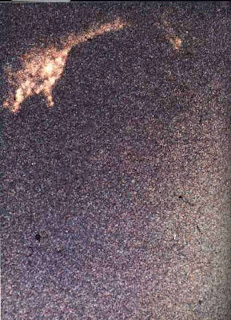 |
| Is this a baby Nessie? |
I know this story is old and many may have heard about it but for me, it's New. I don't know a lot about it and some of the things I'll write may not be completely correct. I do not know where the original story comes from but here is the tale.
Supposedly there was an expedition in 1912 to try and prove the existence of the lake monster we call Nessie.
Alexander Moore, a biologist (?), traveled the lake for three weeks and discovered what was described as a baby Nessie. The baby was already dead when Moore found it but according to the story Moore was able to recover the heart, a kidney and a section of the small intestine. I'm assuming that Moore removed these parts from the dead carcass. These parts are what is seen in the photo above.
Up until 2010 this unusual find was exhibited in the Museum of Curiosity. I'm not sure if this was the somewhat famous traveling museum that was or maybe still is, in London or not.
Now many, from what I gather, say this is nothing more than a hoax and that the mummified creature is nothing more that a creation made out of paper or that it's a known animal that has been altered to appear unusual.
In any case there has been numerous reports of people seeing Nessie over the years, so what if it is really a baby Nessie? What if this creature is really reproducing? I would assume that Nessie sightings will continue for many years but if there is only one Nessie creature then at some point the sightings will stop completely.
Loch Ness Monster
- Wikipedia -
The
Loch Ness Monster is a crypid, reputedly a large unknown animal that inhabits Loch Ness in the Scottish Highlands. It is similar to other supposed lake monsters in Scotland and elsewhere, though its description varies from one account to the next. Popular interest and belief in the animal's existence has varied since it was first brought to the world's attention in 1933. Evidence of its existence is anecdotal, with minimal and much-disputed photographic material and sonar readings.
The most common speculation among believers is that the creature represents a line of long-surviving plesiosaur. The scientific community regards the Loch Ness Monster as a modern-day myth, and explains sightings as including misidentifications of more mundane objects, outright hoaxes, and wishful thinking. Despite this, it remains one of the most famous examples of cryptozoology. The legendary monster has been affectionately referred to by the nickname
Nessie.
- Wikipedia
-
Now while the Wikipedia gives a date of 1933 for Nessie to have been brought to world attention, if this story of a baby Nessie and the three week expedition is true then sightings must have been happening long before 1933.
Thanks for reading.
~Tom~
[Sources: Wikipedia, Wikimedia]
This post sponsored in part by

(Interested in sponsoring a story? then send us an Email!)





























